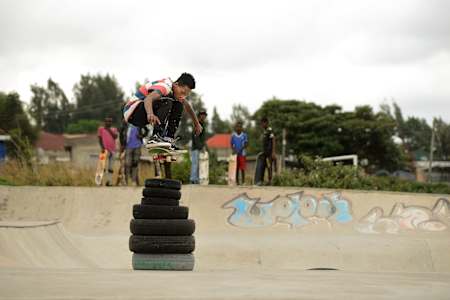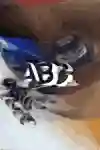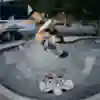Skateboarding

Skateboarding
Here's everything you need to know about how to Ollie on a skateboard
Take a deep dive into all you need to know about refining the techniques required to master the infamous Ollie, from stance to pop.
Whether you are trying to become the next Tony Hawk, or you just want to improve your skateboarding tricks, you can't go wrong with the Ollie. You've seen this classic skateboarding trick everywhere, from amateur skateboarders in every skate park to pros at top-level competitions. So, why not try it yourself?
01
The origins of the Ollie
Allan 'Ollie' Gelfand is the person we have to thank for this iconic skateboarding move. In 1976, he finally figured out a way to do airs on a skateboard without having to actually grab and hold the board with his hands while airborne. However, we should be thanking Rodney Mullen as well, because he's the one who took Allan's trick to a whole new level, naming it the Ollie in Gelfand's honour and helping it become a fundamental part of modern skateboarding.
Today, everyone says that the Ollie is the first trick beginner skateboarders should learn, making it a right-of-passage of sorts.
02
Pre-Ollie skills you need to have

25 min
ABC of... Skateboarding
Take a look at the history of skateboarding, from the pioneers of sidewalk surfing to today's skateboarders.
Before you try a skateboard Ollie, you should have these skateboarding skills nailed:
Pushing off
- Pushing off is a fundamental skill for any skateboarder. After all, it's the skill that makes the difference between actually skateboarding and just standing still. To push off, you need to place your dominant foot on the board and with your non-dominant foot, begin pushing the ground as you accelerate further. Once you get to the speed you desire, bring your non-dominant foot up onto the back of the board.
Kick-turning
- Kick-turning helps you change directions. To kick-turn, place your feet towards the back of your board before pressing down and manoeuvring your feet to redirect the front of your board. Then, resume your usual stance.
Stopping
- Stopping can mean the difference between crashing into something or someone and remaining unscathed – although what would skateboarding be without a few scrapes, right? One way to stop is heel-dragging. Simply place your back foot so that the heel is over the edge and your toes still rest on the board, then lean backwards with your heel and allow it to scrape against the ground. This friction causes your board to come to a stop. Heel-dragging does take some practice, but it works.
03
How to do an Ollie
Now that you know the basics, here's how to do an Ollie on a skateboard:
1. Position your feet
The position of your feet right before you attempt an Ollie is very important. Your back foot should rest in the middle of the tail while your front foot should be placed just after the middle of the board, but before the front truck bolts. This position will help give you the momentum you need to get you and your board airborne.
2. Add the right pressure to the back of your board
With your feet in the optimal position and your back foot still resting in the middle of the tail of your board, apply your weight to your back foot quickly. Do this fast to gain momentum. If you don't do this fast, there might not be enough momentum to get you off the ground to carry out the Ollie successfully.
3. Wait until you feel the board touch the ground to jump
Once you feel the back of your board touch the ground, immediately start your jump.
4. Jump, letting your front foot drag upwards
As you jump, the force of your back foot pressing down on the tail of the board should cause the front of the board to rise upwards at a diagonal angle. As this happens, your front foot, previously resting between the middle and front truck bolts, should also begin to rise and swiftly slide up the board to rest against the nose. This is extremely important for your final landing stance.
5. At the peak of your jump, get ready to land
At the peak of your jump, you and your board should be fully airborne and parallel to the ground. Your back foot should be lightly resting on the truck bolts at the back of the board, while your front foot should be resting on the truck bolts at the front of the board. Having your weight in the right spots is super important, because it helps you keep your balance when you land and prevent you from breaking your board.
6. Bend your knees as your board meets the ground
Once your board hits the ground, let gravity take over. Allow your knees to bend, further allowing your whole body to come to a squatting position on your board. This can help prevent your board from going out from under you and it can also help minimise the impact on your joints once you and your board hit the ground.
Now all you have to do is practise, practise and practise until you conquer it!
04
Useful tips to help you master the Ollie
The Ollie is a must for any skateboarder and you can master it by using a few helpful tips:
Keep your shoulders straight
Believe it or not, it's not just your feet that need to be in the right position prior to landing. You also need to make sure that your shoulders are straight and that they line up with the front and back of your skateboard. If you notice that your shoulders are pointed forward in the direction of your landing, you might have a rough landing and a wipeout instead. Making sure your shoulders match up with the ends of your board when doing the Ollie skateboard trick is paramount to a slick landing.
Start slow
Although you want to get a swift, fluid motion when actually performing an Ollie, in order to master it, you need to start out slow. Pay attention to how it feels when you press your foot down, causing it to scrape the ground. The same goes for the actual jump itself. Over time, you'll get the foot placement down, slide your feet just right as you lift up into the air, and get the technique perfect. Starting slow can help you build up more confidence, making you able to take your skateboarding to the next level.
Make use of your momentum
Even after you crush the Ollie, you might wonder: how do I Ollie even higher? The answer is easier said than done: increase your momentum in the initial jump. If you want to Ollie higher, you first need to get the hang of increasing the fluidity of your motions while also pressing down even harder on the tail of your board. Start by aggressively stomping down on the tail of your board with your back foot. Then, just as quickly, jump up, raising your arms to help your body rise higher off the ground. This is the best way to get a higher Ollie on your skateboard.
Now, what are you waiting for? Get out there and practice the Ollie. This humble trick can quickly lead to more advanced tricks with enough practice.
Explore music to skate to on Spotify
Check out Jagger Eaton's playlist below, or head over to Spotify to hear it there:
Need some more skate inspiration? Follow @redbullskate on Instagram.













